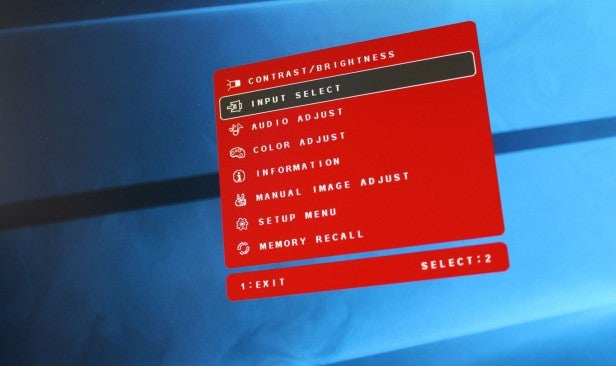ViewSonic XG2700-4K Review - Image Quality, Screen Modes, Uniformity and Verdict Review
Image Quality, Screen Modes, Uniformity and Verdict
Game on with this top-notch 4K screen

Sections
- Page 1 ViewSonic XG2700-4K Review
- Page 2 Image Quality, Screen Modes, Uniformity and Verdict Review
ViewSonic XG2700-4K – Image Quality
My tests at factory settings revealed a decent performance. The initial brightness level of 341 nits is perhaps too high for some, and there’s little to choose between this panel’s contrast ratio of 1,217:1 and the 1,012:1 result churned out by the screen on the Asus ROG Swift PG27AQ. 
Colour quality is only middling: the average Delta E of 2.33 doesn’t compare particularly well to the Asus. Only the colour temperature of 6,397K is a top-notch result.
These scores improved dramatically when I dropped the brightness to 150 nits – a more realistic figure that more people will actually use, and 42/100 on the ViewSonic’s on-screen display. Here the contrast ratio dropped a tad to 1,153:1 but delivered a black level of 0.13 nits – a better overall result, and better than the Asus. At 150 nits, the colour temperature of 6,542K is closer to the key 6,500K result than the Asus’s 6,678K.
It also competes well with the Asus in most key departments. Its contrast and black level results are superior, and its 150 nit colour temperature was closer to the 6,500K ideal than the Asus managed with its brightness toned down.
The ViewSonic only fell behind in a few areas and, even then, the differences were marginal. The ViewSonic’s Delta E of 0.56 is excellent, while the Asus managed an exceptional 0.1. The ViewSonic’s decent Gamma of 2.24 was a little behind the ROG Swift, too, and the ViewSonic displayed 98.8% of the sRGB colour gamut – but the Asus managed 99.2%.
These are all fine margins, with the ViewSonic taking a lead in contrast, black level and colour temperature while the Asus wins in colour accuracy, gamut and Gamma. It’s tricky to pick a clear winner – and, realistically, gamers won’t notice such tiny differences between two excellent panels.
ViewSonic XG2700-4K – Screen Modes
ViewSonic’s screen performed impressively in standard benchmarks, but its huge variety of different screen modes suffered from mixed fortunes. The inconsistencies are encapsulated by this screen’s variety of gaming modes. 
The first FPS mode, for instance, is is far too dim: its brightness level sits at 128 nits and its colour temperature is a chilly 6,700K, and its Delta E declines to a 4.73 average. It’s dark and moody, which doesn’t seem like the best way to show off games.
The second FPS mode goes the other way. Its measured brightness of 333 nits is too bright, and its average Delta E of 1.58 isn’t as good as factory results.
The MOBA option is bright and breezy, with a 334 nit brightness level, but its Delta E declines to 4.52 and its Gamma reading veers away from the 2.2 ideal. The RTS mode isn’t an improvement on factory settings, either, with a dim 128 nit brightness level and a 4.68 Delta E.
The gaming options try to play to the strengths of different genres, but they’re either disarmingly bright or too dim – and none improve colour quality.
The final options concentrate on saving power, but I can’t imagine many people deploying these settings on a gaming monitor. When it’s running at maximum brightness the ViewSonic only needs a modest 34W, and dropping to 150 nits reduced the power consumption 21W. Switching to the Conserve option reduces the power draw to just 14W – but it also reduces the brightness to a near-unusable 43 nits.
Not many of these screen modes are much good. Certain genre options might be useful if you’d like to emphasise certain attributes of those titles, but the ViewSonic’s factory settings are better-balanced.
ViewSonic XG2700-4K – Uniformity and Input Lag
This is one of the first screens I’ve reviewed with a dedicated uniformity option. It’s a good idea, but ViewSonic’s software corrections have unintended impact elsewhere.
With the screen running at its factory settings its uniformity results were reasonable. Along the top edge it lost between 4% and 10% its brightness, with between 2% and 10% of the backlight vanishing in the middle. In the bottom-left corner it didn’t lose any brightness, but it lost 7% in the bottom-right corner.
That’s better than the Asus, which lost a maximum of 10% in one corner – but around 7% in every other corner.
The ViewSonic’s uniformity option reversed those results. With that setting selected the backlight ranged between 0% deviation and a 4% gain along the top row and in the middle of the screen, while along the bottom edge it saw a 6% deviation.
The uniformity mode also improved the ViewSonic’s colour consistency, with colour temperature varying by about 3% with the mode selected – and by about 6% without it. Both of those results are good, but both are marginally worse than the Asus, which varied by about 2%. 
That result is a tad better than the panel’s standard uniformity scores, but I still wouldn’t use it. That’s because the uniformity option hampers the screen elsewhere, with a disappointing contrast ratio of 621:1 and poorer average and maximum Delta Es. That contrast decline in particular is too much to concede for marginally better uniformity, especially when the ViewSonic was already a good performer in this department.
The ViewSonic delivered a selection of input lag results thanks to three different options. The standard mode sat at 25.4ms, which is middling – I consider anything below 20ms an ideal figure for gaming. The ViewSonic’s Advanced mode dipped below that figure with a result of 17.2ms.
The XG2700-4K then averaged 9.4ms when I opted for Extreme mode. That stonking score just managed to sneak ahead of the Asus’ 10ms result. It’s great for gaming, and I’m left wondering why anyone would opt for a different mode when the Extreme option is available.
Should I Buy the ViewSonic XG2700-4K?
The ViewSonic XG2700-4K squares up to the Asus PG27AQ for gaming panel supremacy. It’s a close battle, but I prefer the ViewSonic.
For starters, there’s image quality. This screen has better contrast, black levels and colour temperature than the Asus panel, and its colour accuracy is excellent – barely behind the Republic of Gamers monitor.
There’s little to choose between the two in gamut coverage, and the ViewSonic has slightly better uniformity and input lag results.
The ViewSonic squeezes ahead on features, too. I prefer AMD FreeSync over Nvidia G-Sync, and it has more display connectors and USB ports. It doesn’t look as good and it’s a tad heavier, but they’re minor concerns.
Both of these monitors will deliver smooth 4K gameplay with excellent image quality, but the ViewSonic is my preferred choice – only just.
Verdict
The ViewSonic doesn’t look like the most impressive panel, but it’s got it where it counts. The 4K resolution is bolstered by AMD FreeSync and several game-friendly features, and its image quality is excellent – it either leads rivals or is never far behind. It’s a fantastic choice if you’d like a high-quality 4K gaming panel.
Trusted Score
Score in detail
-
Image Quality 9
-
Design 8
-
Value 8
-
Features 9


